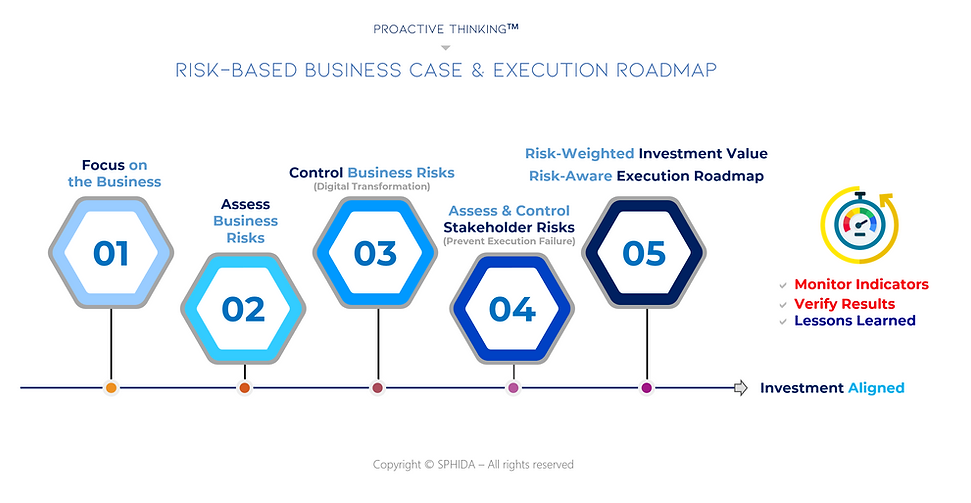
Enable Human Potential
Alignment Methodology
Proactive Thinking 7 Steps Alignment Methodology. The new Six Sigma for the Digital Age.
™

In order to achieve and maintain the alignment of any business process, the Proactive Thinking™ «7 Steps» Methodology» encompasses seven phases. Our proprietary methodology rapidly aligns any business process with management strategic, operational, compliance and reporting objectives.
The methodology can be equally applied to align an Organizational Unit, an IT Service, a Business Function or any other entity belonging to the Governance Universe of the organization. In fact each Governance Entity is always seen as a business process with a responsible manager (Owner), goals to be achieved, inputs (e.g. resources) and outputs (e.g. products and services).
The methodology starts with the FOCUS phase, when goals and related KRIs (Key Results Indicators) are clearly identified. It then maps the activities required to achieve these goals, the people/roles involved, the technologies used, the workplaces involved. Based on these results, it identifies the risks connected to the objectives by using an original proprietary mechanism that establishes the correct priority of both risks and mitigation actions linked to these risks.
From the «7 Steps» also systematically emerges a process Governance Team (key people), an assessment of the achievability of the objectives, the Key Results and Performance Indicators, a concrete prioritized action plan ( who, when, what… ) to achieve the objectives.
In other words the methodology’s output is a clear BUSINESS CASE for CHANGE along with an actionable plan to achieve management’s Goals (set during the initial FOCUS phase).
The Action Plan is then closely monitored over time to ensure actual results.


The Overblue™ software platform
supports the implementation of the Proactive Thinking™ 7 Steps Alignment Methodology.
The new “Six Sigma” for the Digital Age
The Proactive Thinking™ «7 Steps Methodology» was created to respond to the specific needs of the Digital Age.
While retaining what works from previous process analysis & improvement methodologies, such as Six Sigma and Lean, «7 Steps» overcomes the limits of these methodologies.
In fact, methodologies like Six Sigma and Lean were designed to be used in manufacturing (i.e. machine based processes) and not within today’s complex data, information & knowledge driven processes (people).
With Proactive Thinking™ «7 Steps» the focus is no longer the elimination of error and waste (i.e. Lean and Six Sigma), but people's ability to make the best decisions, innovate and solve problems creatively, acting in compliance with corporate policies and regulations.
Investment Strategic alignment

The Proactive Thinking™ «Business Case» methodology is an integral part of the Framework and allows for the «alignment of any Transformation Initiative» (including Digital Transformation Initiatives). This risk-based methodology ensures that:
Transformation initiatives and the related investments have a clear data-driven quantification of the potential value created in terms of achieving management objectives, always measured through quantitative and qualitative indicators (Key Result Indicators)
Execution risks linked to the implementation initiative (roadmap) are always proactively identified and mitigated. The mitigation cost of these risks taken into account when assessing the overall expected value (benefits – costs) of the initiative.
The residual risk (non-mitigable risk) is systematically taken into consideration in the overall assessment of the expected value of the investment (probability of success).